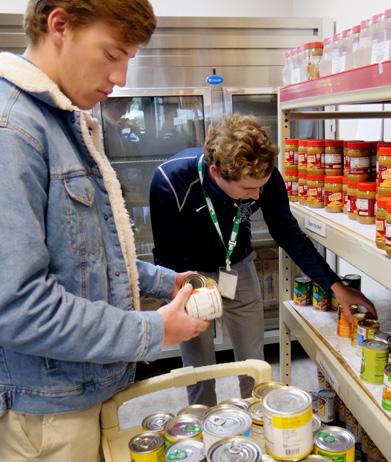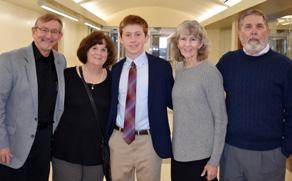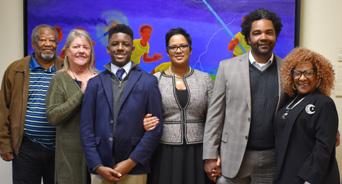
7 minute read
Next Evolution of Service and Justice
A M I N I S T RY OF PRESENCE

A New Way Forward for Service and Justice at Jesuit Dallas

In the spring of 1970, a group of students, faculty, and staff met in Chicago with other Jesuit high schools from around the country to develop a program of renewal in the secondary school apostolate. Three years later, community service at Jesuit Dallas became a graduation requirement.
The program grew spectacularly out of its modest beginnings, and over time, emerged as one of the nation’s benchmark programs. Community service soon found itself as a cornerstone in the educational ethos at Jesuit, with students and faculty contributing over 100,000 hours of combined service over the course of a single calendar year. It wasn’t just that Jesuit Dallas became the largest high school community service department in the State of Texas; but that it was at the forefront of supporting meaningful opportunities for change.
Jesuit Dallas was the first high school in the United States to sponsor an on-campus chapter of Jesuit Refugee Services, whose mission is

focused on reaching out to Africans arriving in the U.S. and to those living in refugee camps in Kenya. Partnering with hundreds of organizations locally and abroad, our students ministered to all people in need – the poor, hungry, or homeless; the sick or injured; the handicapped; the elderly or infirmed; and the intellectually and academically challenged. The commitment became so large, and the output so inspiring, that when Jesuit Dallas would attend events such as the Ignatian Family Teach-In for Justice in Washington, D.C., which it continues to do each fall, our students would take center stage.
Despite the volume of activity, the impact of that work, and the reputation that the School has garnered, the program at Jesuit is in the midst of a paradigm shift in terms of how it views and performs service. Recently, and under the direction of Rich Perry and Michael Reimer ’96, the focus has shifted from counting hours to creating a ministry of presence that at its core is relationship-based. The change in mindset has led to the implementation of “One of the things that concerned Michael and I about our program was that the charitable volunteer work that started with our freshmen was happening without context,” said Perry. “When Father Pedro Arupe first mentioned the phrase of being “men and women for and with others” in his 1973 speech to a group of Jesuit high school alumni in Valencia, Spain, most everyone gravitated to the for, which is both understandable and noble. In this redesign, what our students are experiencing is an emphasis on the with, because philosophically we asked the question, “How can I be for someone if I’m not with them first? How can I be an advocate because the for is the advocacy, but the with is fundamental. You have to start with the with.”
“In listening to a presentation about social justice education some years back, an arch of learning was mapped out that began with an




encounter, which allowed for the development of empathy and a deeper understanding of someone’s needs,” said Reimer. “The charitable work of our freshmen was happening without knowing or understanding who they were serving and without connecting relationally. Because of the way things were structured, it also lessened the impact of those we were trying to serve while the tracking of hours in order to fulfill a graduation requirement became the focus for many of our students.”
The shift of the program has needed to occur in steps, and each new class is now able to experience service and justice in a different way. Juniors and seniors are still carrying on with the previous model, but for underclassmen, the approach is completely different. The options at the freshman level are all about the encounter, while sophomore students are able to go deeper in learning about the special needs that different people face, the challenges unique to their circumstance, how to better understand their livelihood and what we can do to make a real difference.
“The core of this redesign is acknowledging that our students are not doing less, but more,” continued Perry. “There is greater depth, commitment and a strong emphasis on social justice and spiritual formation. It truly is an innovative approach that not only allows for greater empathy, but which also enables our young men to more deeply experience themselves through these encounters.” As juniors, the goal is for students to be able to better reflect on their relationships with the poor, vulnerable and marginalized, as well their understanding of the needs within our community to respond to Christ’s call to put love into action through charity. And by the time a Jesuit student graduates, he will have had the opportunity to understand more deeply the systems of oppression that deny others their basic human rights and developed a sense of compassion and empathy for all victims of injustice.
“Our expectations and model are so different because it is a transformative component for the student itself,” added Reimer. “It’s a civic model. It’s a good thing to go out and help your community but it’s so much more than that. In reading Father Arupe’s speech, it’s clear that our mission is to educate young people for justice. It’s educating them in such a way that they are equipped and inspired to leverage their gifts and talents, and not for themselves, but for the world. That is the core of how Jesuit schools are different. It is a transformative concept to help benefit all of society.”
In some ways, the service structure is still familiar. Every student is required to participate through all four of his years in order to graduate, and each Wednesday during the academic year, our seniors crisscross the metroplex working at 68 physical service sites. Another 40 agencies are regularly supported through the freshman and sophomore programs. And then there are the innumerable one-off projects that dot the calendar.

“The program really has grown dramatically,” said Reimer. “We are doing more impactful work as a school than we ever have and it’s reflected in the student culture. Sometimes in the past, the boys were just going out on the weekends to provide service and then typing up a report. It’s not that anymore. It’s more like, I have an army of student leaders who are eagerly leading 16-18 project sites every weekend.”
Partnering with schools, hospitals, hospice facilities, special education centers, elderly care facilities, immigrant and refugee outreach networks, language centers and environmental programs, Jesuit’s program is truly yearround. The number of summer programs has more than doubled, and through the Dallas Urban Plunge program and service immersion experiences in places such as Peru, Guatemala, and Mexico, our student’s impact touches many parts of the globe.
“We offer an example that is very true to our identity as a Jesuit school, and we are excited to be at the lead in shifting from a quantitative to a qualitative experience,” concluded Perry. “Many schools have expressed interest in moving toward a comparable model, which emphasizes the formation of the student of faith who informs his service and whose service informs his faith. It’s an intersection and the sweet spot is faith and justice coming together.”
GRANDPARENTS DAY







It’s appropriate that Jesuit celebrates Grandparents Day each year around the Thanksgiving holiday. We are certainly thankful for our amazing grandparents and love being able to open up campus for them to explore with their Jesuit grandsons.











